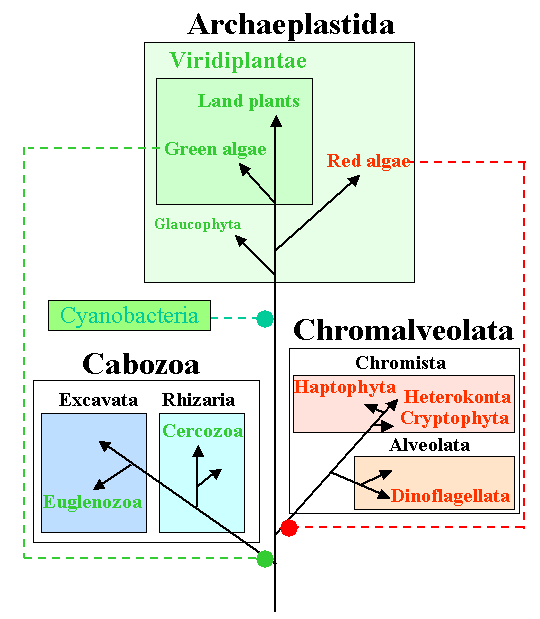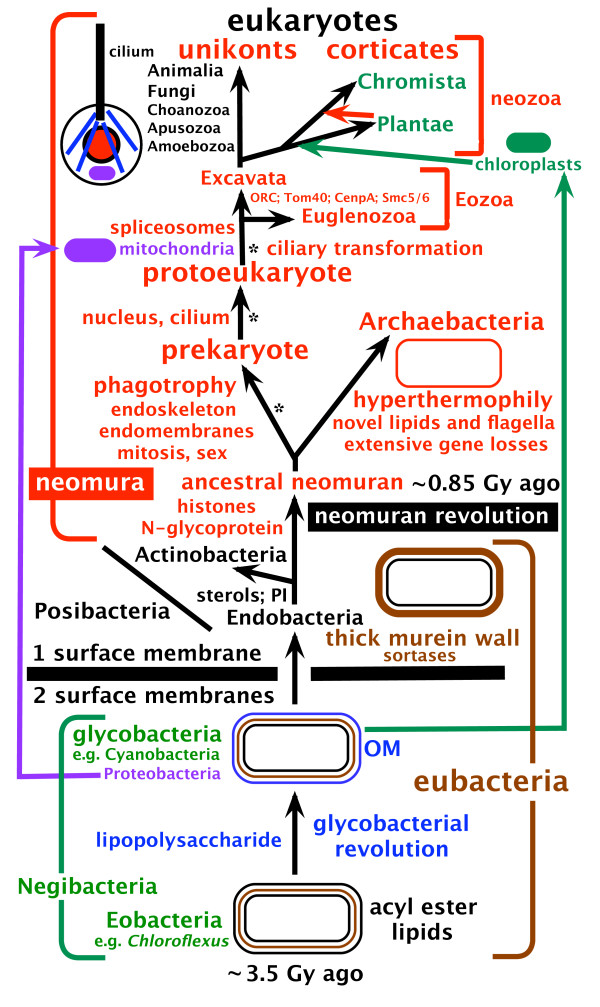|
Cabozoa
In the classification of eukaryotes (living organisms with a cell nucleus), Cabozoa was a taxon proposed by Cavalier-Smith. It was a putative clade comprising the Rhizaria and Excavata. More recent research places the Rhizaria with the Alveolata and Stramenopiles instead of the Excavata, however, so "Cabozoa" is polyphyletic. See also * Corticata Corticata ("one with a cortex"), in the classification of eukaryotes (living organisms with a cell nucleus), is a group suggested by Thomas Cavalier-Smith to encompass the eukaryote supergroups of the following two groups: * Plantae, or Archaep ... References {{bikont-stub Obsolete eukaryote taxa Eukaryote taxa ... [...More Info...] [...Related Items...] OR: [Wikipedia] [Google] [Baidu] |
Corticata
Corticata ("one with a cortex"), in the classification of eukaryotes (living organisms with a cell nucleus), is a group suggested by Thomas Cavalier-Smith to encompass the eukaryote supergroups of the following two groups: * Plantae, or Archaeplastida (land plants, red algae, green algae, and glaucophytes) * Chromalveolata (a polyphyletic group including kelp, water moulds, ciliates, dinoflagellates, and other organisms) Cavalier-Smith later included Rhizaria as well, resulting in a close similarity to Diaphoretickes Diaphoretickes is a major group of eukaryote, eukaryotic organisms spanning over 400,000 species. The majority of the earth's biomass that carries out photosynthesis belongs to Diaphoretickes. In older classification systems, members of the Diaph ... — not identical as Diaphoretickes does not contain polyphyletic taxa. See also * Bikont * Cabozoa References Diaphoretickes taxa Diaphoretickes {{Bikont-stub ... [...More Info...] [...Related Items...] OR: [Wikipedia] [Google] [Baidu] |
Excavata
Excavata is an obsolete, extensive and diverse paraphyletic group of unicellular Eukaryota. The group was first suggested by Simpson and Patterson in 1999 and the name latinized and assigned a rank by Thomas Cavalier-Smith in 2002. It contains a variety of free-living and symbiotic protists, and includes some important parasites of humans such as ''Giardia'' and '' Trichomonas''. Excavates were formerly considered to be included in the now- obsolete Protista kingdom. They were distinguished from other lineages based on electron-microscopic information about how the cells are arranged (they have a distinctive ultrastructural identity). They are considered to be a basal flagellate lineage. On the basis of phylogenomic analyses, the group was shown to contain three widely separated eukaryote groups, the discobids, metamonads, and malawimonads. A current view of the composition of the excavates is given below, indicating that the group is paraphyletic. Except for some Eugleno ... [...More Info...] [...Related Items...] OR: [Wikipedia] [Google] [Baidu] |
Rhizaria
The Rhizaria are a diverse and species-rich clade of mostly unicellular eukaryotes. Except for the Chlorarachniophytes and three species in the genus '' Paulinella'' in the phylum Cercozoa, they are all non-photosynthetic, but many Foraminifera and Radiolaria have a symbiotic relationship with unicellular algae. A multicellular form, ''Guttulinopsis vulgaris'', a cellular slime mold, has been described. This group was used by Cavalier-Smith in 2002, although the term "Rhizaria" had been long used for clades within the currently recognized taxon. Being described mainly from rDNA sequences, they vary considerably in form, having no clear morphological distinctive characters ( synapomorphies), but for the most part they are amoeboids with filose, reticulose, or microtubule-supported pseudopods. In the absence of an apomorphy, the group is ill-defined, and its composition has been very fluid. Some Rhizaria possess mineral exoskeletons ( thecae or loricas), which are in diffe ... [...More Info...] [...Related Items...] OR: [Wikipedia] [Google] [Baidu] |
Eukaryote
The eukaryotes ( ) constitute the Domain (biology), domain of Eukaryota or Eukarya, organisms whose Cell (biology), cells have a membrane-bound cell nucleus, nucleus. All animals, plants, Fungus, fungi, seaweeds, and many unicellular organisms are eukaryotes. They constitute a major group of Outline of life forms, life forms alongside the two groups of prokaryotes: the Bacteria and the Archaea. Eukaryotes represent a small minority of the number of organisms, but given their generally much larger size, their collective global biomass is much larger than that of prokaryotes. The eukaryotes emerged within the archaeal Kingdom (biology), kingdom Asgard (Archaea), Promethearchaeati and its sole phylum Promethearchaeota. This implies that there are only Two-domain system, two domains of life, Bacteria and Archaea, with eukaryotes incorporated among the Archaea. Eukaryotes first emerged during the Paleoproterozoic, likely as Flagellated cell, flagellated cells. The leading evolutiona ... [...More Info...] [...Related Items...] OR: [Wikipedia] [Google] [Baidu] |
Taxon
In biology, a taxon (back-formation from ''taxonomy''; : taxa) is a group of one or more populations of an organism or organisms seen by taxonomists to form a unit. Although neither is required, a taxon is usually known by a particular name and given a particular ranking, especially if and when it is accepted or becomes established. It is very common, however, for taxonomists to remain at odds over what belongs to a taxon and the criteria used for inclusion, especially in the context of rank-based (" Linnaean") nomenclature (much less so under phylogenetic nomenclature). If a taxon is given a formal scientific name, its use is then governed by one of the nomenclature codes specifying which scientific name is correct for a particular grouping. Initial attempts at classifying and ordering organisms (plants and animals) were presumably set forth in prehistoric times by hunter-gatherers, as suggested by the fairly sophisticated folk taxonomies. Much later, Aristotle, and later st ... [...More Info...] [...Related Items...] OR: [Wikipedia] [Google] [Baidu] |
Cavalier-Smith
Thomas (Tom) Cavalier-Smith, Royal Society, FRS, Royal Society of Canada, FRSC, Natural Environment Research Council, NERC Professorial Fellow (21 October 1942 – 19 March 2021), was a professor of evolutionary biology in the Department of Zoology, at the University of Oxford. His research has led to discovery of a number of unicellular organisms (protists) and advocated for a variety of major taxonomic groups, such as the Chromista, Chromalveolata, Opisthokonta, Rhizaria, and Excavata. He was known for Cavalier-Smith's system of classification, his systems of classification of all organisms. Life and career Cavalier-Smith was born on 21 October 1942 in London. His parents were Mary Maude (née Bratt) and Alan Hailes Spencer Cavalier Smith. He was educated at Norwich School (educational institution), Norwich School, Gonville and Caius College, Cambridge (MA) in Biology and King's College London (PhD) in Zoology. He was under the supervision of John Randall (phys ... [...More Info...] [...Related Items...] OR: [Wikipedia] [Google] [Baidu] |
Clade
In biology, a clade (), also known as a Monophyly, monophyletic group or natural group, is a group of organisms that is composed of a common ancestor and all of its descendants. Clades are the fundamental unit of cladistics, a modern approach to taxonomy adopted by most biological fields. The common ancestor may be an individual, a population, or a species (extinct or Extant taxon, extant). Clades are nested, one in another, as each branch in turn splits into smaller branches. These splits reflect evolutionary history as populations diverged and evolved independently. Clades are termed ''monophyletic'' (Greek: "one clan") groups. Over the last few decades, the cladistic approach has revolutionized biological classification and revealed surprising evolutionary relationships among organisms. Increasingly, taxonomists try to avoid naming Taxon, taxa that are not clades; that is, taxa that are not Monophyly, monophyletic. Some of the relationships between organisms that the molecul ... [...More Info...] [...Related Items...] OR: [Wikipedia] [Google] [Baidu] |
Stramenopile
The stramenopiles, also called heterokonts, are protists distinguished by the presence of stiff tripartite external hairs. In most species, the hairs are attached to flagella, in some they are attached to other areas of the cellular surface, and in some they have been secondarily lost (in which case relatedness to stramenopile ancestors is evident from other shared cytological features or from genetic similarity). Stramenopiles represent one of the three major clades in the SAR supergroup, along with Alveolata and Rhizaria. Stramenopiles are eukaryotes; most are single-celled, but some are multicellular including some large seaweeds, the brown algae. The group includes a variety of algal protists, heterotrophic flagellates, opalines and closely related proteromonad flagellates (all endobionts in other organisms); the actinophryid Heliozoa, and oomycetes. The tripartite hairs characteristic of the group have been lost in some of the included taxa – for example in most ... [...More Info...] [...Related Items...] OR: [Wikipedia] [Google] [Baidu] |
Obsolete Eukaryote Taxa
Obsolescence is the process of becoming antiquated, out of date, old-fashioned, no longer in general use, or no longer useful, or the condition of being in such a state. When used in a biological sense, it means imperfect or rudimentary when compared with the corresponding part of other organisms. The international standard IEC 62402:2019 Obsolescence Management defines obsolescence as the "transition from available to unavailable from the manufacturer in accordance with the original specification". Obsolescence frequently occurs because a replacement has become available that has, in sum, more advantages compared to the disadvantages incurred by maintaining or repairing the original. Obsolete also refers to something that is already disused or discarded, or antiquated. Typically, obsolescence is preceded by a gradual decline in popularity. Consequences Driven by rapid technological changes, new components are developed and launched on the market with increasing speed. The resul ... [...More Info...] [...Related Items...] OR: [Wikipedia] [Google] [Baidu] |




